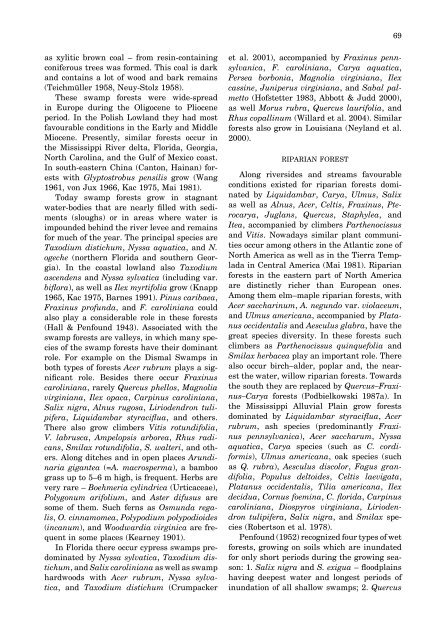Middle Miocene palynoflora of the Legnica lignite deposit complex ...
Middle Miocene palynoflora of the Legnica lignite deposit complex ...
Middle Miocene palynoflora of the Legnica lignite deposit complex ...
Create successful ePaper yourself
Turn your PDF publications into a flip-book with our unique Google optimized e-Paper software.
as xylitic brown coal – from resin-containing<br />
coniferous trees was formed. This coal is dark<br />
and contains a lot <strong>of</strong> wood and bark remains<br />
(Teichmüller 1958, Neuy-Stolz 1958).<br />
These swamp forests were wide-spread<br />
in Europe during <strong>the</strong> Oligocene to Pliocene<br />
period. In <strong>the</strong> Polish Lowland <strong>the</strong>y had most<br />
favourable conditions in <strong>the</strong> Early and <strong>Middle</strong><br />
<strong>Miocene</strong>. Presently, similar forests occur in<br />
<strong>the</strong> Mississippi River delta, Florida, Georgia,<br />
North Carolina, and <strong>the</strong> Gulf <strong>of</strong> Mexico coast.<br />
In south-eastern China (Canton, Hainan) forests<br />
with Glyptostrobus pensilis grow (Wang<br />
1961, von Jux 1966, Kac 1975, Mai 1981).<br />
Today swamp forests grow in stagnant<br />
water-bodies that are nearly fi lled with sediments<br />
(sloughs) or in areas where water is<br />
impounded behind <strong>the</strong> river levee and remains<br />
for much <strong>of</strong> <strong>the</strong> year. The principal species are<br />
Taxodium distichum, Nyssa aquatica, and N.<br />
ogeche (nor<strong>the</strong>rn Florida and sou<strong>the</strong>rn Georgia).<br />
In <strong>the</strong> coastal lowland also Taxodium<br />
ascendens and Nyssa sylvatica (including var.<br />
bifl ora), as well as Ilex myrtifolia grow (Knapp<br />
1965, Kac 1975, Barnes 1991). Pinus caribaea,<br />
Fraxinus pr<strong>of</strong>unda, and F. caroliniana could<br />
also play a considerable role in <strong>the</strong>se forests<br />
(Hall & Penfound 1943). Associated with <strong>the</strong><br />
swamp forests are valleys, in which many species<br />
<strong>of</strong> <strong>the</strong> swamp forests have <strong>the</strong>ir dominant<br />
role. For example on <strong>the</strong> Dismal Swamps in<br />
both types <strong>of</strong> forests Acer rubrum plays a signifi<br />
cant role. Besides <strong>the</strong>re occur Fraxinus<br />
caroliniana, rarely Quercus phellos, Magnolia<br />
virginiana, Ilex opaca, Carpinus caroliniana,<br />
Salix nigra, Alnus rugosa, Liriodendron tulipifera,<br />
Liquidambar styracifl ua, and o<strong>the</strong>rs.<br />
There also grow climbers Vitis rotundifolia,<br />
V. labrusca, Ampelopsis arborea, Rhus radicans,<br />
Smilax rotundifolia, S. walteri, and o<strong>the</strong>rs.<br />
Along ditches and in open places Arundinaria<br />
gigantea (=A. macrosperma), a bamboo<br />
grass up to 5–6 m high, is frequent. Herbs are<br />
very rare – Boehmeria cylindrica (Urticaceae),<br />
Polygonum arifolium, and Aster difusus are<br />
some <strong>of</strong> <strong>the</strong>m. Such ferns as Osmunda regalis,<br />
O. cinnamomea, Polypodium polypodioides<br />
(incanum), and Woodwardia virginica are frequent<br />
in some places (Kearney 1901).<br />
In Florida <strong>the</strong>re occur cypress swamps predominated<br />
by Nyssa sylvatica, Taxodium distichum,<br />
and Salix caroliniana as well as swamp<br />
hardwoods with Acer rubrum, Nyssa sylvatica,<br />
and Taxodium distichum (Crumpacker<br />
69<br />
et al. 2001), accompanied by Fraxinus pennsylvanica,<br />
F. caroliniana, Carya aquatica,<br />
Persea borbonia, Magnolia virginiana, Ilex<br />
cassine, Juniperus virginiana, and Sabal palmetto<br />
(H<strong>of</strong>stetter 1983, Abbott & Judd 2000),<br />
as well Morus rubra, Quercus laurifolia, and<br />
Rhus copallinum (Willard et al. 2004). Similar<br />
forests also grow in Louisiana (Neyland et al.<br />
2000).<br />
RIPARIAN FOREST<br />
Along riversides and streams favourable<br />
conditions existed for riparian forests dominated<br />
by Liquidambar, Carya, Ulmus, Salix<br />
as well as Alnus, Acer, Celtis, Fraxinus, Pterocarya,<br />
Juglans, Quercus, Staphylea, and<br />
Itea, accompanied by climbers Par<strong>the</strong>nocissus<br />
and Vitis. Nowadays similar plant communities<br />
occur among o<strong>the</strong>rs in <strong>the</strong> Atlantic zone <strong>of</strong><br />
North America as well as in <strong>the</strong> Tierra Templada<br />
in Central America (Mai 1981). Riparian<br />
forests in <strong>the</strong> eastern part <strong>of</strong> North America<br />
are distinctly richer than European ones.<br />
Among <strong>the</strong>m elm–maple riparian forests, with<br />
Acer saccharinum, A. negundo var. violaceum,<br />
and Ulmus americana, accompanied by Platanus<br />
occidentalis and Aesculus glabra, have <strong>the</strong><br />
great species diversity. In <strong>the</strong>se forests such<br />
climbers as Par<strong>the</strong>nocissus quinquefolia and<br />
Smilax herbacea play an important role. There<br />
also occur birch–alder, poplar and, <strong>the</strong> nearest<br />
<strong>the</strong> water, willow riparian forests. Towards<br />
<strong>the</strong> south <strong>the</strong>y are replaced by Quercus–Fraxinus–Carya<br />
forests (Podbielkowski 1987a). In<br />
<strong>the</strong> Mississippi Alluvial Plain grow forests<br />
dominated by Liquidambar styracifl ua, Acer<br />
rubrum, ash species (predominantly Fraxinus<br />
pennsylvanica), Acer saccharum, Nyssa<br />
aquatica, Carya species (such as C. cordiformis),<br />
Ulmus americana, oak species (such<br />
as Q. rubra), Aesculus discolor, Fagus grandifolia,<br />
Populus deltoides, Celtis laevigata,<br />
Platanus occidentalis, Tilia americana, Ilex<br />
decidua, Cornus foemina, C. fl orida, Carpinus<br />
caroliniana, Diospyros virginiana, Liriodendron<br />
tulipifera, Salix nigra, and Smilax species<br />
(Robertson et al. 1978).<br />
Penfound (1952) recognized four types <strong>of</strong> wet<br />
forests, growing on soils which are inundated<br />
for only short periods during <strong>the</strong> growing season:<br />
1. Salix nigra and S. exigua – fl oodplains<br />
having deepest water and longest periods <strong>of</strong><br />
inundation <strong>of</strong> all shallow swamps; 2. Quercus

















